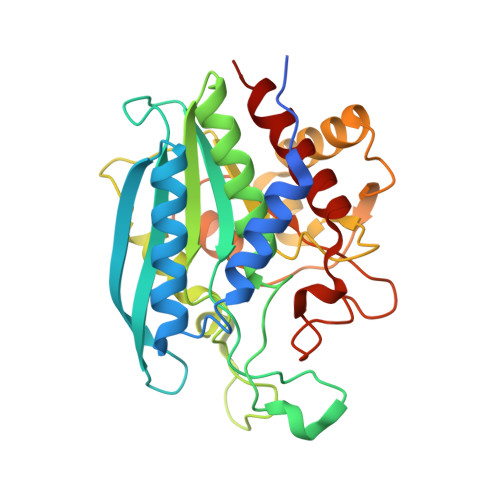A Unique Carboxylic-Acid Hydrogen-Bond Network (CAHBN) Confers Glutaminyl Cyclase Activity on M28 Family Enzymes.
Huang, K.F., Huang, J.S., Wu, M.L., Hsieh, W.L., Hsu, K.C., Hsu, H.L., Ko, T.P., Wang, A.H.(2021) J Mol Biology 433: 166960-166960
- PubMed: 33774034
- DOI: https://doi.org/10.1016/j.jmb.2021.166960
- Primary Citation of Related Structures:
7D17, 7D18, 7D1B, 7D1D, 7D1E, 7D1H, 7D1N, 7D1P, 7D1Y, 7D21, 7D23, 7D2B, 7D2D, 7D2I, 7D2J - PubMed Abstract:
Proteins with sequence or structure similar to those of di-Zn exopeptidases are usually classified as the M28-family enzymes, including the mammalian-type glutaminyl cyclases (QCs). QC catalyzes protein N-terminal pyroglutamate formation, a posttranslational modification important under many physiological and pathological conditions, and is a drug target for treating neurodegenerative diseases, cancers and inflammatory disorders. Without functional characterization, mammalian QCs and their orthologs remain indistinguishable at the sequence and structure levels from other M28-family proteins, leading to few reported QCs. Here, we show that a low-barrier carboxylic-acid hydrogen-bond network (CAHBN) is required for QC activity and discriminates QCs from M28-family peptidases. We demonstrate that the CAHBN-containing M28 peptidases deposited in the PDB are indeed QCs. Our analyses identify several thousands of QCs from the three domains of life, and we enzymatically and structurally characterize several. For the first time, the interplay between a CAHBN and the binuclear metal-binding center of mammalian QCs is made clear. We found that the presence or absence of CAHBN is a key discriminator for the formation of either the mono-Zn QCs or the di-Zn exopeptidases. Our study helps explain the possible roles of QCs in life.
- Institute of Biological Chemistry, Academia Sinica, Taipei 11529, Taiwan. Electronic address: huangkf@gate.sinica.edu.tw.
Organizational Affiliation:


















